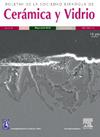Analyzing the manufacturing phases of alumina-based porcelain insulators
IF 2.7
4区 材料科学
Q1 MATERIALS SCIENCE, CERAMICS
Boletin de la Sociedad Espanola de Ceramica y Vidrio
Pub Date : 2025-07-15
DOI:10.1016/j.bsecv.2025.100456
引用次数: 0
Abstract
Alumina-based insulators are widely used in regions with extreme temperature fluctuations, such as polar areas, due to their high mechanical strength, low thermal expansion, and excellent electrical insulation properties. To improve the reliability of electrical transmission lines in such environments, a detailed understanding of their structural and physical characteristics is needed. This study investigates the mechanical and microstructural properties of high-strength alumina-based insulators using X-ray diffraction (XRD) and scanning electron microscopy with energy-dispersive X-ray analysis (SEM-EDAX). The manufacturing process is analyzed, focusing on density, porosity, and phase structure validation. The results show that increased mullite formation within the insulator structure improves mechanical strength, especially with low porosity (10.8%), having homogeneous size distribution and high density (2.73 g/cm3). Strength tests indicate that the produced insulators resist forces up to 14 kN. Among the samples, those produced using alumina powder show better mechanical strength and reliability, likely due to more controlled mullite formation and reduced impurity content. As a result, an improved production process for reliable alumina-based C12.5-650 insulators was produced. These findings provide valuable insights for significantly improving the production of alumina-based insulators for harsh environments.
分析了铝基瓷绝缘子的制造阶段
铝基绝缘子具有机械强度高、热膨胀小、电绝缘性能优异等特点,广泛应用于极端温度波动地区,如极地地区。为了提高这种环境下输电线路的可靠性,需要详细了解其结构和物理特性。利用x射线衍射仪(XRD)和扫描电子显微镜(SEM-EDAX)研究了高强度铝基绝缘体的力学和微观结构性能。分析了制造工艺,重点是密度、孔隙率和相结构验证。结果表明:增加莫来石在绝缘子结构内的形成,提高了绝缘子的机械强度,特别是在低孔隙率(10.8%)、尺寸分布均匀、密度高(2.73 g/cm3)的绝缘子结构中;强度测试表明,所生产的绝缘子可抵抗高达14千牛的力。在这些样品中,使用氧化铝粉生产的样品表现出更好的机械强度和可靠性,可能是由于更容易控制莫来石的形成和减少杂质含量。结果,改进了可靠的铝基C12.5-650绝缘子的生产工艺。这些发现为显著改善恶劣环境下铝基绝缘体的生产提供了有价值的见解。
本文章由计算机程序翻译,如有差异,请以英文原文为准。
求助全文
约1分钟内获得全文
求助全文
来源期刊

Boletin de la Sociedad Espanola de Ceramica y Vidrio
工程技术-材料科学:硅酸盐
CiteScore
5.50
自引率
2.90%
发文量
72
审稿时长
103 days
期刊介绍:
The Journal of the Spanish Ceramic and Glass Society publishes scientific articles and communications describing original research and reviews relating to ceramic materials and glasses. The main interests are on novel generic science and technology establishing the relationships between synthesis, processing microstructure and properties of materials. Papers may deal with ceramics and glasses included in any of the conventional categories: structural, functional, traditional, composites and cultural heritage. The main objective of the Journal of the Spanish Ceramic and Glass Society is to sustain a high standard research quality by means of appropriate reviewing procedures.
 求助内容:
求助内容: 应助结果提醒方式:
应助结果提醒方式:


